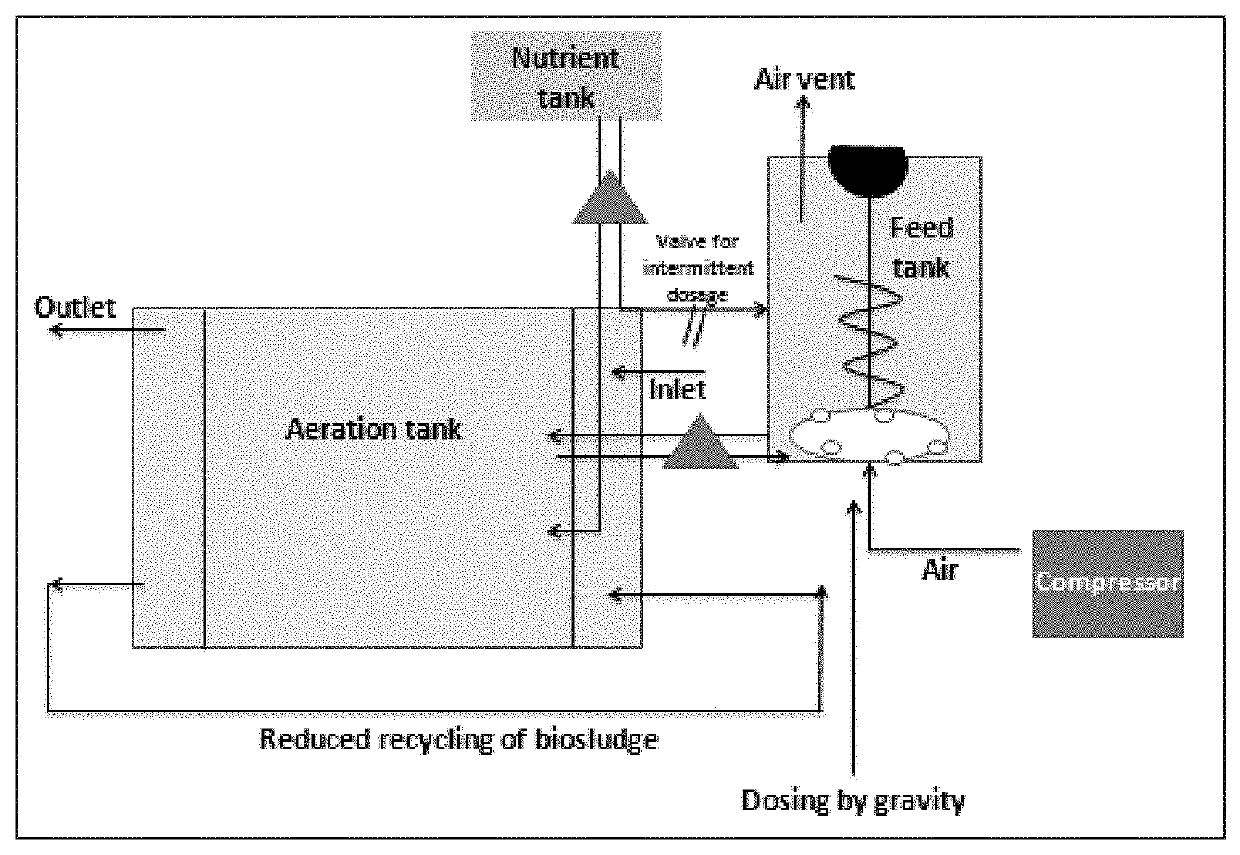Process for bio-sludge reduction in hydrocarbon refinery effluent treatment plant through microbial interventions
a technology of hydrocarbon refinery and effluent treatment plant, which is applied in the direction of biological water/sewage treatment, water/sludge/sewage treatment, water contaminants, etc., can solve the problems of reducing the carbon removal and modification of sludge compaction properties, affecting the biological recovery of industrial wastewater, and affecting the biochemical recovery of industrial wastewater
- Summary
- Abstract
- Description
- Claims
- Application Information
AI Technical Summary
Benefits of technology
Problems solved by technology
Method used
Image
Examples
example-1
[0078]Microbial consortium comprising of the aforesaid characteristics was prepared using Pseudomonas stutzferi (MTCC 25027), Bacillus subtilis (MTCC 25026) Bacillus substilis (MTCC 5386), Pseudomonas aeruginosa (MTCC 5389), Lysinibacillus sp. (MTCC 5666), Lysinibacillus sp. (MTCC 25029) are used as example.
[0079]The said microbial blend has a very good expression of Surfactin synthetase complex (srfAD) and Phosphopantetheinyl transferase (sfp) genes for producing biosurfactants called, surfactin. The consortium also has good expression of Catechol 1, 2 dioxygenase (catA), Naphthalene dioxygenase (nahH), Alkane monooxygenase (alkB and alkB1) genes for degrading the aromatics and aliphatics respectively. The consortium also has very good expression of Long chain alkane monooxygenase (ladA) for degrading the long chain alkanes / paraffins. The consortium also has a good expression of Persulfide dioxygenase (pdo) gene, Catechol 2, 3 dioxygenase (xylE) and Chromate Reductase (chrR) genes ...
example-2
[0082]The microbial consortia consisting of Bacillus subtilis (MTCC 25026) Bacillus substilis (MTCC 5386), Pseudomonas aeruginosa (MTCC 5389), Bacillus stearothermophilus (MTCC 25030), Lysinibacillus sp. (MTCC 5666), were evaluated to decontaminate the refinery wastewater in a continuous CSTR. The microbial count was maintained at 102 cfu / ml. The ratio of Pseudomonas and Bacillus was maintained 2:10. The performance of the consortia was compared with activated sludge obtained from the refinery. The performance comparison is as follows:
[0083]
After treatmentBeforeActivatedMicrobial consortiaParametertreatmentsludgedisclosed in this inventionO&G (ppm)55508.73.95Phenol (ppm)121.230.22Sulphide (ppm)231.740.28MLSS (ppm)35461030Bio-sludge generation7.691.16in treating 100 L water(g, dry weight)
example -
Example-:3
[0084]The microbial consortia consisting of Pseudomonas stutzferi (MTCC 25027) Bacillus subtilis (MTCC 25026) Lysinibacillus sp. (MTCC 5666), Pseudomonas putida IOCR1 (MTCC 5387), Lysinibacillus sp. (MTCC 25029) were evaluated to decontaminate the refinery wastewater in a continuous CSTR. The microbial count was maintained at 104 cfu / ml. The ratio of Pseudomonas and Bacillus was maintained 1:10. The performance of the consortia was compared with activated sludge obtained from the refinery. The performance comparison is as follows:
[0085]
After treatmentMicrobial Activated consortia disclosedParameterInletsludgein this inventionO&G (ppm)55508.71.2Phenol (ppm)121.230.09Sulphide (ppm)231.740.06MLSS (ppm)3546720Bio-sludge generation7.690.86in treating 100 L water(g, dry weight)
PUM
| Property | Measurement | Unit |
|---|---|---|
| temperature | aaaaa | aaaaa |
| concentration | aaaaa | aaaaa |
| retention time | aaaaa | aaaaa |
Abstract
Description
Claims
Application Information
 Login to View More
Login to View More - R&D
- Intellectual Property
- Life Sciences
- Materials
- Tech Scout
- Unparalleled Data Quality
- Higher Quality Content
- 60% Fewer Hallucinations
Browse by: Latest US Patents, China's latest patents, Technical Efficacy Thesaurus, Application Domain, Technology Topic, Popular Technical Reports.
© 2025 PatSnap. All rights reserved.Legal|Privacy policy|Modern Slavery Act Transparency Statement|Sitemap|About US| Contact US: help@patsnap.com

